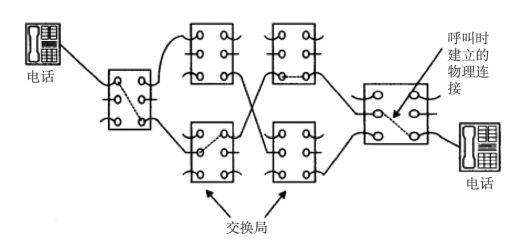【摘要】:上述早期广域网基本采用电路交换方式将电路临时分配给一对通信用户使用,只有其挂机后其他的用户才能使用。为了和苏联在高科技领域展开对抗,美国1958年成立了ARPA负责高科技研究。
任何试图彻底追踪一件事情起源的做法,都被证明是极为困难的,首先遇到的难题便是很难确定从哪里开始。[79]计算机诞生伊始是以计算为中心的庞然大物,为更好地发挥其数据处理功能,计算机科研人员尝试通过调解器、公共电话网等硬件设备实现计算机与各类终端相连,进而实现远距离不同计算机之间彼此连接。连接是计算机从“人—机”传播转向“机—机”传播乃至“人—人”间传播的起点,也是孕育互联网、将社会网络逐步数字化的原点,具有重要的传播学意义。
1.基于电话线路直接连接的internet网络
早期计算机体积庞大、操作复杂,需要专业人员提前输入特定算法才能处理成批信息,远距离用户使用非常不方便。20世纪60年代初,随着计算机在工业、商业、军事等部门被广泛使用,越来越多的数据同样需要进行批处理,商业公司、高等院校、政府部门开始尝试通过调解器、电话等通信设备将不同地区的计算机连接在一起,以便数据(信息)传递。从最早单机工作模式,到有通信功能(单机)脱机批处理系统,再到有通信功能的(单机)联机系统,计算机从孤立走向连接,人与计算机远距离信息传递逐步实现,具体如图4-2-1所示。
由图4-2-1可知,计算机最初只能实现“人—机”间信息互动,通信技术与计算机技术结使得“人—机—人”传播成为可能,计算机开始作为人际交流的“中介”出现,现实中人际关系开始映射到虚拟internet空间。

图4-2-1 左:单机模式,中:有通信功能脱机,右:有通信功能联机[80]
随着计算机用户数量和终端数量不断增加,原有单机联机越来越难以满足信息处理需求,前端处理机的发明有效地解决了这一问题,如图4-2-2所示。

图4-2-2 具有通信功能的多机系统[81]
20世纪60年代,这种面向终端计算机通信网借助已有公用电话网获得很大发展,尤以IBM公司负责牵头研制的SAGE(Semi-Automatic Ground Environment)最为知名,甚至有研究者将这种只有一台中心计算机的简单计算机网络称为第一代计算机网络。[82]后逐渐演化为公共电话交换网(Public Switched Telephone Network,PSTN),其工作原理如图4-2-3所示。

图4-2-3 局域网通过PSTN连接示意图[83]
由图4-2-3可知,鉴于每个节点都为可以提供网络接入服务,PSTN成为特定群体工作关系的虚拟映射空间。
上述早期广域网(Wide Area Network,WAN)基本采用电路交换(Circuit Switching,CS)方式将电路临时分配给一对通信用户使用,只有其挂机后其他的用户才能使用。这一模式下,实现计算机之间通信依靠电话网(PSTN)的物理连接,如图4-2-4所示。

图4-2-4 电路交换的工作模式[84](www.chuimin.cn)
拨号过程中电话网中的程控交换机建立物理通路,通话双方在通话过程中始终占有整个端到端的通路,通常被称之为电路交换,与今天互联网有很大不同。
2.阿帕网成立推动internet向Internet过渡
1957年苏联成功发射第一个人造地球卫星Sputnik,震惊了世界。为了和苏联在高科技领域展开对抗,美国1958年成立了ARPA(Advanced Research Projects Agency,高等研究计划局)负责高科技研究。[85]1962年利克莱德(J.C.R.Licklider)博士受邀担任该局指令和控制研究室(CCR)主任,他招募一批优秀科学家从事计算机网络研究,并自作主张将CCR改名为IPTO(信息处理技术办公室)。[86]正是在这一大背景下,利克莱德带领一大批科学家、工程师于1969年正式发明因特网(Internet)的前身——ARPAnet,利克莱德所著《备忘录:星系间计算机网络的成员和附属机构》(Memorandum For:Members and Affiliates of the Intergalactic Computer Network,1963)更成为建构阿帕网的宏伟蓝图:
It is difficult to determine,of course,what constitutes“group advantage”.Even at the risk of confusing my own individual objectives(or ARPA's)with those of the“group,”however,let me try to set forth some of the things that might be,in some sense,group or system or network desiderata.There will be programming languages,debugging languages.
There will be programming languages,debugging languages,time-sharing system control languages,computer-network languages,data-base(or file-storage-and-retrieval languages),and perhaps other languages as well.It may or may not be a good idea to oppose or to constrain lightly the proliferation of such.However,there seems to me to be little question that it is desirable to foster“transfer of training”among these languages.One way in which transfer can be facilitated is to follow group consensus in the making of the arbitrary and nearly-arbitrary decisions that arise in the design and implementation of languages.There would be little point,for example,in having a diversity of symbols,one for each individual or one for each center,to designate“contents of”or“type the contents of.”It seems to me desirable to have as much homogeneity as can reasonably be achieved in the set of sub-languages of a given language system-the system,for example,of programming,debugging,and time-sharing-control languages related to JOVIAL on the Q-32,or the system related to Algol(if such were developed and turned out to be different from the JOVIAL set)for the Q-32 computer,or the set related to FORTRAN for a 7090 or a 7094.
…
There is an analogous problem,and probably a more difficult one,in the matter of language for the control of a network of computers.Consider the situation in which several different centers are netted together,each center being highly individualistic and having its own special language and its own special way of doing things.Is it not desirable,or even necessary for all the centers to agree upon some language or,at least,upon some conventions for asking such questions as“What language do you speak?”At this extreme,the problem is essentially the one discussed by science fiction writers:“how do you get communications started among totally uncorrelated‘sapient’beings?”But,I should not like to make an extreme assumption about the uncorrelatedness.(I am willing to make an extreme assumption about the sapience.)The more practical set of questions is:Is the network control language the same thing as the time-sharing control language?(If so,the implication is that there is a common time-sharing control language.)Is the network control language different from the time-sharing control language,and is the networkcontrol language common to the several netted facilities?Is there no such thing as a network-control language?(Does one,for example,simply control his own computer in such a way as to connect it into whatever part of the alreadyoperating net he likes,and then shift over to an appropriate mode?)
It will possibly turn out,I realize,that only on rare occasions do most or all of the computers in the overall system operate together in an integrated network.It seems to me to be interesting and important,nevertheless,to develop a capability for integrated network operation.If such a network as I envisage nebulously could be brought into operation,we would have at least four large computers,perhaps six or eight small computers,and a great assortment of disc files and magnetic tape units-not to mention the remote consoles and teletype stations-all churning away.It seems easiest to approach this matter from the individual user's point of view-to see what he would like to have,what he might like to do,and then to try to figure out how to make a system within which his requirements can be met.
利克莱德关于互联网的“想象”不仅为之后数十年的互联网发展规划“路径”,而且从一开始便将互联网视为不同智慧生物交流的工具和媒介。
最初,ARPAnet连接的主机数只有4台,缘于军事保密要求,就技术而言还不具备向外推广的条件。随着社会发展,网络技术应用领域不断扩大,学校、企业也发展成为网络应用的主体。到了1971年,ARPAnet已经连接了美国加州大学洛杉矶分校、斯坦福研究院、加州大学圣芭芭拉分校、犹他州大学、BBN公司、麻省理工学院等15个节点,连接主机数增加到23台。[87]1983年阿帕网分割成两部分:军用部分称为MILnet,民用部分仍称为ARPAnet。1985年美国国家科学基金会为方便科学家们进行交流,建立了广域网(National Science Foundation Network,NSFnet),该网于1988年替代阿帕网,成为当时美国的主干网,而阿帕网则于次年关闭,运行十年后NSFnet于1995年关闭。
3.包切换与分时系统推动internet演进
1966年6月,英国国家物理实验室(NPL)的戴维斯(Davies)首次提出“包切换”(Pack Switching)理论,美国科学家将这一理论应用到网络数据传输中并取得巨大成功。[88]包切换技术是将数据加上信头、地址、错误校验码、传输控制信息后经由不同的路径传输,其技术本质是将信息分解为若干部分,每一部分可以由不同路径发送,最后在终点重新组合成完整的内容。这种信息传送方式摆脱了对单一传播渠道的依赖,使得信息总有办法可以完成传送,具有传播效率高、传输容量大、传输距离远等优点,缺点是安全性和保密性差、不易控制。在美苏争霸的时代背景下,美国半数的网络设施被破坏才会影响信息的传输,且只是减慢信息传播速度,更加费时而已。[89]包切换技术至今仍是互联网运行的核心技术之一,互联网去中心化、匿名性等诸多传播特性均与这一技术创新有着密不可分联系。[90]
包切换技术的发明推动分时系统演进发展,所谓分时系统(time sharing system)简单来说就是一台高性能主机连接多个终端,允许多个用户同时通过终端共享主机资源。其工作原理就像餐厅,主机就是后厨,不同餐桌就是不同终端,客人就座后点餐(终端操作),后厨(主机)将时间分成若干段,依次为不同餐桌(终端)提供饭菜(服务),这样不仅能够充分利用(后厨),而且不影响客户点餐(终端操作)。分时系统的发明使得不同终端同时共享信息成为可能,为互联网普及奠定了重要的技术基础。
4.TCP/IP协议发明推动Internet正式诞生
连接不同计算机除电铜线、光纤等“有线”介质,微波、红外线、卫星等“无线”介质外,还必须有某种约定和规则(即协议)以实现信息交换。[91]最初由于缺乏通信协议,不同类型计算机之间信息传输非常困难。1970年12月卡恩开发、瑟夫等制定最早的计算机通信协议——“网络控制协议”(NCP),之后其他科学家、技术人员相继推出不同的计算机通信协议,想要建立一个得到广泛承认的通用标准非常困难。1972年10月,国际电脑通信大会结束后,科学家开始尝试建立计算机通信通用标准。包切换技术、分时系统为网络间的连接奠定技术基础,卡恩在自己研究的基础上,邀请请瑟夫共同制定“传输控制协议”(Transmission Control Protocol,TCP)和“因特网协议”(Internet Protocol,IP),即TCP/IP协议,[92]Internet由此正式诞生。











相关推荐